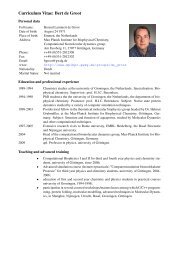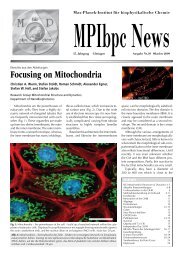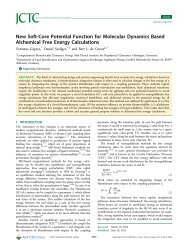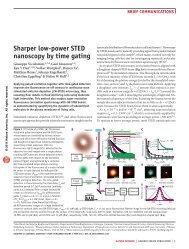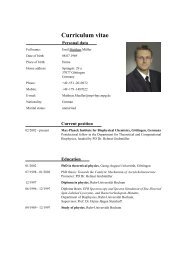Elastic Properties of Photoswitchable Azobenzene Polymers from ...
Elastic Properties of Photoswitchable Azobenzene Polymers from ...
Elastic Properties of Photoswitchable Azobenzene Polymers from ...
Create successful ePaper yourself
Turn your PDF publications into a flip-book with our unique Google optimized e-Paper software.
persistence lengths Lp. These lengths obtained <strong>from</strong> the<br />
simulations range <strong>from</strong> 0.40 nm to 0.97 nm and agree with the<br />
experimental value <strong>of</strong> 0.5 nm (Table 1) within our statistical<br />
accuracy. We found Lp (R 2<br />
free ) to be quite sensitive to the<br />
details <strong>of</strong> the fit. The quality <strong>of</strong> the fit did not drop<br />
significantly when the experimental value <strong>of</strong> Lp = 0.5 nm<br />
was used (R 2<br />
fix in Table 1). This good agreement between<br />
theory and experiment validates the force field applied and<br />
renders finite size effects <strong>of</strong> the dodecamers used as model<br />
systems for the more extended azobenzene polymers used in<br />
the AFM experiments unlikely. Further tests to confirm the<br />
validity <strong>of</strong> our approach are presented in the Supporting<br />
Information.<br />
Table 1: WLC parameters <strong>of</strong> all-trans polymers obtained <strong>from</strong> experiment<br />
and <strong>from</strong> our force-probe MD simulations. [a]<br />
Dl/monomer<br />
[Š]<br />
L c/monomer<br />
[nm]<br />
L p [nm] R 2<br />
free<br />
experiment [22] 0.60 1.90 0.50<br />
simulation 1.45 2.05 0.97 0.88 0.85<br />
[a] WLC parameters were obtained by modeling the force-extension data<br />
with the extended WLC model [Eq. (1)]. The extension difference Dl per<br />
switched azobenzene monomer is given at a force <strong>of</strong> 200 pN to enable<br />
direct comparison with the experimental data. Two different values are<br />
given for R 2 ; these values reflect the quality <strong>of</strong> the fits. R 2<br />
free was obtained<br />
<strong>from</strong> a WLC fit with both Lc and Lp as adjustable parameters, whereas R 2<br />
fix<br />
was obtained <strong>from</strong> a fit with Lp = 0.5 nm, which is the value obtained<br />
<strong>from</strong> the experimental data.<br />
The WLC fits were also used to extract the extension<br />
differences Dl between the trans and cis polymers <strong>from</strong> the<br />
simulations. As illustrated in Figure 2b, Dl determines the<br />
work output upon contraction against an external load.<br />
Therefore, an increase in Dl improves the efficiency <strong>of</strong> the<br />
optomechanical energy conversion caused by the polymers.<br />
The extension difference between the cis and trans states<br />
<strong>of</strong> an isolated azobenzene molecule was estimated <strong>from</strong><br />
quantum-chemical calculations to be 2.5 Š. [29] However, the<br />
polymer typically does not undergo the corresponding length<br />
change, because at low forces (F < 200 pN) the azobenzene<br />
monomers are not aligned perfectly, and thus only part <strong>of</strong> the<br />
cis–trans length change <strong>of</strong> the monomer is available in the<br />
pulling direction. In contrast, at higher forces the polymers<br />
are aligned to a larger extent, and thus could undergo larger<br />
length changes. However, trans-azobenzene is considerably<br />
stiffer than cis-azobenzene (see the Supporting Information),<br />
which again reduces the observed length change. From our<br />
simulations, in which these effects were taken fully into<br />
account, we predict an extension difference <strong>of</strong> about 1.3 to<br />
1.5 Š per switched azobenzene unit. As the measured<br />
extension difference <strong>of</strong> about 0.6 Š is still smaller by more<br />
than a factor <strong>of</strong> two (Table 1), the work output might be<br />
improved. Closer inspection shows that only part <strong>of</strong> this<br />
reduction in polymer-length change, Dl, can be explained by<br />
the above two effects.<br />
To identify the origin <strong>of</strong> the as yet unexplained reduction<br />
in Dl, we decomposed the overall force-extension curves into<br />
the contributions <strong>of</strong> the individual polymer building blocks.<br />
R2<br />
fix<br />
Angewandte<br />
Chemie<br />
Indeed, the extension difference due solely to the azobenzene<br />
units is 1.70 Š per monomer (dashed green line in Figure 2c),<br />
which is the value expected <strong>from</strong> polymer tilt and differential<br />
stiffness. This contribution to Dl is larger than the total<br />
extension difference <strong>of</strong> 1.45 Š for the polymer (Figure 2a).<br />
Figure 2d shows that the difference <strong>of</strong> about 0.25 Š can be<br />
attributed to the lysine residues, which therefore partly<br />
compensate the “optical” lengthening and contraction <strong>of</strong><br />
the azo groups. The force-extension curves <strong>of</strong> the glycine<br />
residues are rather independent <strong>of</strong> the azobenzene conformation<br />
(Figure 2d, inset).<br />
As shown schematically on the right-hand side <strong>of</strong> Figure<br />
3d, the compensation by lysine residues is due to the<br />
isomerization <strong>of</strong> the lysine backbone between an extended<br />
anti and a more compact syn conformation around the<br />
backbone dihedral angle Y. These two conformers are<br />
populated to different extents, depending on whether the<br />
Figure 3. Syn–anti conformational switching <strong>of</strong> lysine amino acids.<br />
a) Sketch <strong>of</strong> the all-cis (top), mixed (middle), and all-trans polymers<br />
(bottom). <strong>Azobenzene</strong> units in the cis conformation are shown as<br />
yellow circles, those in the trans conformation as turquoise rectangles.<br />
b, c) Exemplarily, the backbone dihedral angles Y <strong>of</strong> Lys7 in the all-cis<br />
and all-trans polymers are plotted as a function <strong>of</strong> the applied force.<br />
Averages <strong>of</strong> Y were calculated with a 50-pN window. Error bars<br />
represent the errors <strong>of</strong> the mean and are also typical for the data<br />
shown in panel (d). d) Extended anti and compact syn lysine conformations<br />
interconvert by rotation about the backbone dihedral angle Y<br />
(right). Averaged Y angles <strong>of</strong> all individual lysine monomers are<br />
plotted as a function <strong>of</strong> the applied force for the all-cis (blue), all-trans<br />
(red), and mixed polymers (black) for Lys4 (solid), Lys7 (dash-dotted),<br />
and Lys10 (dashed line). All forces were obtained at a pulling velocity<br />
<strong>of</strong> 0.1 nmns 1 . The areas shaded in gray indicate the extended anti<br />
and the more compact syn conformations. Lys1 is directly attached to<br />
the harmonic pulling potential (see Figure 1d) and was therefore<br />
excluded <strong>from</strong> the analysis.<br />
Angew. Chem. 2007, 119, 1 – 7 2007 Wiley-VCH Verlag GmbH & Co. KGaA, Weinheim www.angewandte.de<br />
These are not the final page numbers! Ü Ü<br />
3




